On the Origin and Evolution of the Intra-Cluster Light: A Brief Review of the Most Recent Developments
Abstract
1. Introduction
2. Definition of the ICL
2.1. Observational Methods
2.2. Theoretical Methods
3. Formation Mechanisms
3.1. Pre-Processing
3.2. Mergers
3.3. Stellar Stripping
4. Properties of the ICL
4.1. ICL Fraction
4.2. ICL Colors, Metallicity and Age
4.3. BCG-ICL Evolution
5. ICL: An Observable Tracer of the Dark Matter Distribution
6. Summary and Conclusions
Funding
Data Availability Statement
Conflicts of Interest
References
- Zwicky, F. On the Masses of Nebulae and of Clusters of Nebulae. Astrophys. J. 1937, 86, 217. [Google Scholar] [CrossRef]
- Montes, M. The Intracluster Light and its Role in Galaxy Evolution in Clusters. arXiv 2019, arXiv:1912.01616. [Google Scholar]
- Gonzalez, A.H.; Sivanandam, S.; Zabludoff, A.I.; Zaritsky, D. Galaxy Cluster Baryon Fractions Revisited. Astrophys. J. 2013, 778, 14. [Google Scholar] [CrossRef]
- Contini, E.; De Lucia, G.; Villalobos, Á.; Borgani, S. On the Formation and Physical Properties of the Intracluster Light in Hierarchical Galaxy Formation Models. Mon. Not. R. Astron. Soc. 2014, 437, 3787–3802. [Google Scholar] [CrossRef]
- Presotto, V.; Girardi, M.; Nonino, M.; Mercurio, A.; Grillo, C.; Rosati, P.; Biviano, A.; Annunziatella, M.; Balestra, I.; Cui, W.; et al. Intracluster Light Properties in the CLASH-VLT Clusters MACS J1206.2-0847. Astron. Astrophys. 2014, 565, A126. [Google Scholar] [CrossRef]
- Contini, E.; Yi, S.K.; Kang, X. The Different Growth Pathways of Brightest Cluster Galaxies and Intracluster Light. Mon. Not. R. Astron. Soc. 2018, 479, 932–944. [Google Scholar]
- Arnaboldi, M.; Ventimiglia, G.; Iodice, E.; Gerhard, O. A Tale of two Tails and an Off-Centered Envelope: Diffuse Light Around the cD Galaxy NGC3311 in the Hydra I Cluster. Astron. Astrophys. 2012, 545, A37. [Google Scholar] [CrossRef]
- Edwards, L.O.V.; Alpert, H.S.; Trierweiler, I.L.; Abraham, T.; Beizer, V.G. Stellar Populations of BCGs, Close Companions and Intracluster Light in Abell85, Abell2457 and IIZw108. Mon. Not. R. Astron. Soc. 2016, 461, 230–239. [Google Scholar] [CrossRef]
- Kravtsov, A.V.; Vikhlinin, A.A.; Meshcheryakov, A.V. Stellar Mass-Halo Mass Relation and Star Formation Efficiency in High-Mass Halos. Astron. Lett. 2018, 44, 8–34. [Google Scholar] [CrossRef]
- Zhang, Y.; Yanny, B.; Palmese, A.; Gruen, D.; To, C.; Rykoff, E.S.; Leung, Y.; Collins, C.; Hilton, M.; Abbott, T.M.C.; et al. Dark Energy Survey Year 1 Results: Detection of Intracluster Light at Redshift ∼0.25. Astrophys. J. 2019, 874, 165. [Google Scholar] [CrossRef]
- DeMaio, T.; Gonzalez, A.H.; Zabludoff, A.; Zaritsky, D.; Aldering, G.; Brodwin, M.; Connor, T.; Donahue, M.; Hayden, B.; Mulchaey, J.S.; et al. The Growth of Brightest Cluster Galaxies and Intracluster Light Over the Past 10 Billion Years. Mon. Not. R. Astron. Soc. 2020, 491, 3751–3759. [Google Scholar] [CrossRef]
- Montes, M.; Brough, S.; Owers, M.; Santucci, G. The Buildup of the Intracluster Light of A85 as Sees by Subaru’s Hyper Suprime-Cam. Astrophys. J. 2021, 910, 45. [Google Scholar] [CrossRef]
- Rudick, C.S.; Mihos, J.C.; McBride, C.K. The Quantity of Intracluster Light: Comparing Theoretical and Observational Measurement Techiques Using Simulated Clusters. Astrophys. J. 2011, 732, 48. [Google Scholar] [CrossRef]
- Cui, W.; Murante, G.; Monaco, P.; Borgani, S.; Granato, G.L.; Killedar, M.; Lucia, G.D.; Presotto, V.; Dolag, K. Characterizing Diffused Stellar Light in Simulated Galaxy Clusters. Mon. Not. R. Astron. Soc. 2014, 437, 816–830. [Google Scholar] [CrossRef]
- Jimenez-Teja, Y.; Dupke, R. Disentangling the ICL with the CHEFs: Abell 2744 as a Case Study. Astrophys. J. 2016, 820, 49. [Google Scholar] [CrossRef]
- Montes, M.; Trujillo, I. Intracluster Light at the Frontier - II. The Frontier Fields Clusters. Mon. Not. R. Astron. Soc. 2018, 474, 917–932. [Google Scholar] [CrossRef]
- Tang, L.; Lin, W.; Cui, W.; Kang, X.; Wang, Y.; Contini, E.; Yu, Y. An Investigation of Intracluster Light Evolution Using Cosmological Hydrodynamical Simulations. Astrophys. J. 2018, 859, 85. [Google Scholar] [CrossRef]
- Dolag, K.; Murante, G.; Borgani, S. Dynamical Difference Between the cD Galaxy and the Diffuse, Stellar Component in Simulated Galaxy Clusters. Mon. Not. R. Astron. Soc. 2010, 405, 1544–1559. [Google Scholar] [CrossRef]
- Somerville, R.S.; Hopkins, P.E.; Cox, T.J.; Robertson, B.E.; Hernquist, L. A Semi-Analytic Model for the Co-Evolution of Galaxies, Black Holes and Active Galactic Nuclei. Mon. Not. R. Astron. Soc. 2008, 391, 481–506. [Google Scholar] [CrossRef]
- Henriques, B.M.B.; Thomas, P.A. Tidal Disruption of Satellite Galaxies in a Semi-Analytic Model of Galaxy Formation. Mon. Not. R. Astron. Soc. 2010, 403, 768–779. [Google Scholar] [CrossRef]
- Guo, Q.; White, S.; Boylan-Kolchin, M.; Lucia, G.; Kauffmann, G.; Lemson, G.; Li, C.; Springel, V.; Weinmann, S. From Dwarf Spheroidals to cD Galaxies: Simulating the Galaxy Population in a &ΛCDM Cosmology. Mon. Not. R. Astron. Soc. 2011, 413, 101–131. [Google Scholar]
- Feldmeier, J.; Mihos, J.C.; Morrison, H.; Harding, P.; Kaib, N.; Dubinski, J. Deep CCD Surface Photometry of Galaxy Clusters II. Searching for Intracluster Starlight in Non-cD clusters. Astrophys. J. 2004, 609, 617–637. [Google Scholar] [CrossRef]
- Zibetti, S.; White, S.; Schneider, D.P.; Brinkmann, J. Intergalactic Stars in z ∼ 0.25 Galaxy Clusters: Systematic Properties from Stacking of Sloan Digital Sky Survey Imaging Data. Mon. Not. R. Astron. Soc. 2005, 358, 949–967. [Google Scholar] [CrossRef]
- Furnell, K.E.; Collins, C.A.; Kelvin, L.S.; Baldry, I.K.; James, P.J.; Manolopoulou, M.; Mann, R.G.; Giles, P.A.; Bermeo, A.; Hilton, M. The Growth of Intracluster Light in XCS-HSC Galaxy Clusters from 0.1 < z < 0.5. Mon. Not. R. Astron. Soc. 2021, 502, 2419–2437. [Google Scholar]
- Sersic, J.L. Cordoba, Argentina: Observatorio Astronomico; Universidad Nacional de Córdoba: Córdoba, Argentina, 1968. [Google Scholar]
- Gonzalez, A.; Zabludoff, A.I.; Zaritsky, D. Intracluster Light in Nearby Galaxy Cluster: Relationship to the Halos of Brightest Cluster Galaxies. Astrophys. J. 2005, 618, 195–213. [Google Scholar] [CrossRef]
- Seigar, M.S.; Graham, A.W.; Jerjen, H. Intracluster Light and the Extended Stellar Envelopes of cD Galaxies: An Analytical Description. Mon. Not. R. Astron. Soc. 2007, 378, 1575–1588. [Google Scholar] [CrossRef]
- Donzelli, C.J.; Muriel, H.; Madrid, J.P. The Luminosity Profiles of Brightest Cluster Galaxies. Astrophys. J. Supp. 2011, 195, 15. [Google Scholar] [CrossRef]
- Giallongo, E.; Menci, N.; Grazian, A.; Gallozzi., S.; Castellano, M.; Fiore, F.; Fontana, A.; Pentericci, L.; Boutsia, K.; Paris, D. Diffuse Optical Intracluster Light as a Measure of Stellar Tidal Stripping: The Cluster CL0024+17 at z ∼ 0.4 Observed at the Large Binocular Telescope. Astrophys. J. 2015, 781, 24. [Google Scholar] [CrossRef]
- Cooper, A.P.; Gao, L.; Guo, Q.; Frenk, C.S.; Jenkins, A. Surface Photometry of Brightest Cluster Galaxies and Intracluster Stars in &ΛCDM. Mon. Not. R. Astron. Soc. 2015, 451, 2703–2722. [Google Scholar]
- Alamo-Martinez, K.A.; Blakeslee, J.P. Specific Frequencies and Luminosity Profiles of Cluster Galaxies and Intracluster Light in Abell1689. Astrophys. J. 2017, 849, 6. [Google Scholar] [CrossRef]
- Durret, F.; Tarricq, Y.; Marquez, I.; Ashkar, H.; Adami, C. Link Between Brightest Cluster Galaxy Properties and Large Scale Extensions of 38 DAFT/FADA and CLASH Clusters in the Redshift Range 0.2 < z < 0.9. Astron. Astrophys. 2019, 622, A78. [Google Scholar]
- Kluge, M.; Bender, R.; Riffeser, A.; Goessl, C.; Hopp, U.; Schmidt, M.; Ries, C. Photometric Dissection of Intracluster Light and Its Correlations with Host Cluster Properties. Astrophys. J. Supp. 2021, 252, 27. [Google Scholar] [CrossRef]
- Schuberth, Y.; Richtler, T.; Bassino, L.; Hilker, M. Intra-cluster globular clusters around NGC 1399 in Fornax? Astron. Astrophys. 2008, 477, L9. [Google Scholar] [CrossRef]
- D’Abrusco, R.; Cantiello, M.; Paolillo, M.; Pota, V.; Napolitano, N.R.; Limatola, L.; Spavone, M.; Grado, A.; Iodice, E.; Capaccioli, M. The Extended Spatial Distribution of Globular Clusters in the Core of the Fornax Cluster. Astrophys. J. Lett. 2016, 819, L31. [Google Scholar] [CrossRef]
- Cantiello, M.; Venhola, A.; Grado, A.; Paolillo, M.; D’Abrusco, R.; Raimondo, G.; Quintini, M.; Hilker, K.; Mieske, S.; Tortora, C.; et al. The Fornax Deep Survey with VST. IX. Catalog of sources in the FDS area with an example study for globular clusters and background galaxies. Astron. Astrophys. 2020, 639, A136. [Google Scholar] [CrossRef]
- Lee, M.G.; Park, H.S.; Hwang, H.S. Detection of a Large-Scale Structure of Intracluster Globular Clusters in the Virgo Cluster. Science 2010, 328, 334. [Google Scholar] [CrossRef] [PubMed]
- Durrell, P.R.; Côté, P.; Peng, E.W.; Blakeslee, J. The Next Generation Virgo Cluster Survey. VIII. The Spatial Distribution of Globular Clusters in the Virgo Cluster. Astrophys. J. 2014, 794, 103. [Google Scholar] [CrossRef]
- Ko, Y.; Hwang, H.S.; Lee, M.G.; Park, H.S.; Lim, S.; Sohn, J.; Jang, I.S.; Hwang, N.; Park, B.G. To the Edge of M87 and Beyond: Spectroscopy of Intracluster Globular Clusters and Ultracompact Dwarfs in the Virgo Cluster. Astrophys. J. 2017, 835, 212. [Google Scholar] [CrossRef]
- Longobardi, A.; Peng, E.W.; Côté, P.; Mihos, J.C.; Ferrarese, L.; Puzia, T.H.; Lançon, A.; Zhang, H.; Muñoz, R.P.; Blakeslee, J.P.; et al. The Next Generation Virgo Cluster Survey (NGVS). XXXI. The Kinematics of Intracluster Globular Clusters in the Core of the Virgo Cluster. Astrophys. J. 2018, 864, 36. [Google Scholar] [CrossRef]
- Harris, W.E.; Brown, R.A.; Durrell, P.R.; Romanowsky, A.J.; Blakeslee, J.; Brodie, J.; Janssens, S.; Lisker, T.; Okamoto, S.; Wittmann, S.; et al. The PIPER Survey. I. An Initial Look at the Intergalactic Globular Cluster Population in the Perseus Cluster. Astrophys. J. 2020, 890, 105. [Google Scholar] [CrossRef]
- Peng, E.W.; Ferguson, H.C.; Goudfrooij, P.; Hammer, D.; Lucey, J.R.; Marzke, R.O.; Puzia, T.H.; Carter, D.; Balcells, M.; Bridges, T.; et al. The HST/ACS Coma Cluster Survey. IV. Intergalactic Globular Clusters and the Massive Globular Cluster System at the Core of the Coma Galaxy Cluster. Astrophys. J. 2011, 730, 23. [Google Scholar] [CrossRef]
- Madrid, J.P.; O’Neill, C.R.; Gagliano, A.T.; Marvil, J.R. A Wide-field Map of Intracluster Globular Clusters in Coma. Astrophys. J. 2018, 867, 144. [Google Scholar] [CrossRef]
- West, M.J.; Jordán, A.; Blakeslee, J.P.; Côté, P.; Gregg, M.D.; Takamiya, M.; Marzke, R.O. The globular cluster systems of Abell 1185. Astron. Astrophys. 2011, 528, A115. [Google Scholar] [CrossRef]
- Longobardi, A.; Arnaboldi, M.; Gerhard, O.; Hanuschik, R. The outer regions of the giant Virgo galaxy M 87 Kinematic separation of stellar halo and intracluster light. Astron. Astrophys. 2015, 579, A135. [Google Scholar] [CrossRef]
- Kelson, D.D.; Zabludoff, A.I.; Williams, K.A.; Trager, S.C.; Mulchaey, J.S.; Bolte, M. Determination of the Dark Matter Profile of A2199 from Integrated Starlight. Astrophys. J. 2002, 576, 720. [Google Scholar] [CrossRef]
- Bender, R.; Kormendy, J.; Cornell, M.E.; Fisher, D.B. Structure and Formation of cD Galaxies: NGC 6166 in ABELL 2199. Astrophys. J. 2015, 807, 56. [Google Scholar] [CrossRef]
- Monaco, P.; Murante, G.; Borgani, S.; Fontanot, F. Diffuse Stellar Component in Galaxy Clusters and the Evolution of the Most Massive Galaxies at z < 1. Astrophys. J. 2006, 652, L89–L92. [Google Scholar]
- Murante, G.; Giovalli, M.; Gerhard, O.; Arnaboldi, M.; Borgani, S.; Dolag, K. The Importance of Mergers for the Origin of Intracluster Stars in Cosmological Simulations of Galaxy Clusters. Mon. Not. R. Astron. Soc. 2007, 377, 2–16. [Google Scholar] [CrossRef]
- Gerhard, O.; Arnaboldi, M.; Freeman, K.C.; Okamura, S.; Kashikawa, N.; Yasuda, N. The Kinematics of Intracluster Planetary Nebulae and the On-Going Subcluster Merger in the Coma Cluster Core. Astron. Astrophys. 2007, 468, 815–822. [Google Scholar] [CrossRef]
- Burke, C.; Hilton, M.; Collins, C. Coevolution of Brightest Cluster Galaxies and Intracluster Light Using CLASH. Mon. Not. R. Astron. Soc. 2015, 449, 2353–2367. [Google Scholar] [CrossRef]
- Groenewald, D.N.; Skelton, R.E.; Gilbank, D.G.; Loubser, S.I. The Close Pair Fraction of BCGs Since z = 0.5: Major Mergers Dominate Recent BCG Stellar Mass Growth. Mon. Not. R. Astron. Soc. 2017, 467, 4101–4117. [Google Scholar] [CrossRef]
- Jimenez-Teja, Y.; Dupke, R.; Benitez, N.; Koekemoer, A.M.; Zitrin, A.; Umetsu, K.; Ziegler, B.L.; Frye, B.L.; Ford, H.; Bouwens, R.J.; et al. Unveiling the Dynamical State of Massive Clusters Through the ICL Fraction. Astrophys. J. 2018, 857, 19. [Google Scholar] [CrossRef]
- Jimenez-Teja, Y.; Dupke, R.; Lopes de Oliveira, R.; Xavier, H.S.; Coelho, P.R.T.; Chies-Santos, A.L.; López-Sanjuan, C.; Alvarez-Candal, A.; Costa-Duarte, M.V.; Telles, E.; et al. J-PLUS: Analysis of the Intracluster Light in the Coma Cluster. Astron. Astrophys. 2019, 622, A183. [Google Scholar] [CrossRef]
- Purcell, C.W.; Bullock, J.S.; Zentner, A.R. Shredded Galaxies as the Source of Diffuse Intrahalo Light on Varying Scales. Astrophys. J. 2007, 666, 20–33. [Google Scholar] [CrossRef]
- Conroy, C.; Wechsler, R.H.; Kravtsov, A.V. The Hierarchical Build-Up of Massive Galaxies and the Intracluster Light Since z = 1. Astrophys. J. 2007, 668, 826–838. [Google Scholar] [CrossRef]
- Martel, H.; Barai, P.; Brito, W. The Fate of Dwarf Galaxies in Cluster and the Origin of Intracluster Stars II. Cosmological Simulations. Astrophys. J. 2012, 757, 48. [Google Scholar] [CrossRef]
- Annunziatella, M.; Mercurio, A.; Biviano, A.; Girardi, M.; Nonino, M.; Balestra, I.; Rosati, P.; Caminha, G.B.; Brescia, M.; Gobat, R.; et al. CLASH-VLT: Environmental-driven Evolution of Galaxies in the z = 0.209 Cluster Abell 209. Astron. Astrophys. 2016, 585, A160. [Google Scholar] [CrossRef]
- Morishita, T.; Abramson, L.E.; Treu, T.; Schmidt, K.B.; Vulcani, B.; Wang, X. Characterizing Intracluster Light in the Hubble Frontier Fields. Astrophys. J. 2017, 846, 139. [Google Scholar] [CrossRef]
- Raj, M.A.; Iodice, E.; Napolitano, N.R.; Hilker, M.; Spavone, M.; Peletier, R.F.; Su, H.-S.; Falcón-Barroso, J.; Ven, G.v.d.; Cantiello, M.; et al. The Fornax Deep Survey with VST. X. The Assembly History of the Bright Galaxies and Intra-Group Light in the Fornax A Subgroup. Astron. Astrophys. 2020, 640, A137. [Google Scholar] [CrossRef]
- Rudick, C.S.; Mihos, J.C.; Frey, L.H.; McBride, C.K. Tidal Streams of Intracluster Light. Astrophys. J. 2009, 699, 1518–1529. [Google Scholar] [CrossRef]
- DeMaio, T.; Gonzalez, A.H.; Zabludoff, A.; Zaritsky, D.B. On the Origin of the Intracluster Light in Massive Galaxy Clusters. Mon. Not. R. Astron. Soc. 2015, 448, 1162–1177. [Google Scholar] [CrossRef]
- DeMaio, T.; Gonzalez, A.H.; Zabludoff, A.; Zaritsky, D.; Connor, T.; Donahue, M.; Mulchaey, J.S. Lost but not Forgotten: Intracluster Light in Galaxy Groups and Clusters. Mon. Not. R. Astron. Soc. 2018, 474, 3009–3031. [Google Scholar] [CrossRef]
- Willman, B.; Governato, F.; Wadsley, J.; Quinn, T. The Origin and Properties of Intracluster Stars in a Rich Cluster. Mon. Not. R. Astron. Soc. 2004, 355, 159–168. [Google Scholar] [CrossRef]
- Mihos, J.C.; Harding, P.; Feldmeier, J.; Morrison, H. Diffuse Light in the Virgo Cluster. Astrophys. J. 2005, 631, L41–L44. [Google Scholar] [CrossRef]
- Rudick, C.S.; Mihos, J.C.; McBride, C. The Formation and Evolution of Intracluster Light. Astrophys. J. 2006, 648, 936–946. [Google Scholar] [CrossRef]
- Sommer-Larsen, J. Properties of Intra-group Stars and Galaxies in Galaxy Groups: “Normal” versus “Fossil” Groups. Mon. Not. R. Astron. Soc. 2006, 369, 958–968. [Google Scholar] [CrossRef]
- Puchwein, E.; Springel, V.; Sijacki, D.; Dolag, K. Intracluster Stars in Simulations with Active Galactic Nucleus Feedback. Mon. Not. R. Astron. Soc. 2010, 406, 936–951. [Google Scholar] [CrossRef]
- Melnick, J.; Giraud, E.; Toledo, I.; Selman, F.; Quintana, H. Intergalactic Stellar Populations in Intermediate Redshift Clusters. Mon. Not. R. Astron. Soc. 2012, 427, 850–858. [Google Scholar] [CrossRef]
- Montes, M.; Trujillo, I. Intracluster Light at the Frontier: A2744. Astrophys. J. 2014, 794, 137. [Google Scholar] [CrossRef]
- Krick, J.E.; Bernstein, R.A.; Pimbblet, K.A. Diffuse Optical Light in Galaxy Clusters. I. Abell 3888. Astrophys. J. 2006, 131, 168–184. [Google Scholar] [CrossRef]
- Krick, J.E.; Bernstein, R.A. Diffuse Optical Light in Galaxy Clusters. II. Correlations with Cluster Properties. Astrophys. J. 2007, 134, 466–493. [Google Scholar] [CrossRef]
- Rudick, C.S.; Mihos, J.C.; Harding, P.; Feldmeier, J.J.; Janowiecki, S.; Morrison, H.L. Optical Colors of Intracluster Light in the Virgo Cluster. Astrophys. J. 2010, 720, 569–580. [Google Scholar] [CrossRef]
- Toledo, I.; Melnick, J.; Selman, F.; Quintana, H.; Giraud, E.; Zelaya, P. Diffuse Intracluster Light at Intermediate Redshifts: Intracluster Light Observations in an X-ray Cluster at z = 0.29. Mon. Not. R. Astron. Soc. 2011, 414, 602–614. [Google Scholar] [CrossRef]
- Iodice, E.; Spavone, M.; Cantiello, M.; DAbrusco, R.; Capaccioli, M.; Hilker, M.; Mieske, S.; Napolitano, N.; Peletier, R.; Limatola, L.; et al. Intracluster Patches of Baryons in the Core of the Fornax Cluster. Astrophys. J. 2017, 851, 75. [Google Scholar] [CrossRef]
- Harris, K.A.; Debattista, V.P.; Governato, F.; Thompson, B.B.; Clarke, A.J.; Quinn, T.; Willman, B.; Benson, A.; Farrah, D.; Peng, E.W.; et al. Quantifying the Origin and Distribution of Intracluster Light in a Fornax-Like Cluster. Mon. Not. R. Astron. Soc. 2017, 467, 4501–4513. [Google Scholar] [CrossRef]
- Contini, E.; Yi, S.K.; Kang, X. Theoretical Predictions of Colors and Metallicity of the Intracluster Light. Astrophys. J. 2019, 871, 24. [Google Scholar] [CrossRef]
- Spavone, M.; Iodice, E.; van de Ven, G.; Falcón-Barroso, J.; Raj, M.A.; Hilker, M.; Peletier, R.P.; Capaccioli, M.; Mieske, S.; Venhola, A.; et al. The Fornax Deep Survey with VST. VIII. Connecting the Accretion History with the Cluster Density. Astron. Astrophys. 2020, 639, A14. [Google Scholar] [CrossRef]
- Edwards, L.O.V.; Salinas, M.; Stanley, S.; West, P.E.H.; Trierweiler, I.; Alpert, H.; Coelho, P.; Koppaka, S.; Tremblay, G.R.; Martel, H.; et al. Clocking the Formation of Today’s Largest Galaxies: Wide Field Spectroscopy of Brightest Cluster Galaxies and Their Surroundings. Mon. Not. R. Astron. Soc. 2020, 491, 2617–2638. [Google Scholar] [CrossRef]
- Gu, M.; Conroy, C.; Law, D.; Dokkum, P.V.; Yan, R.; Wake, D.; Bundy, K.; Villaume, A.; Abraham, R.; Merritt, A.; et al. Spectroscopic Constraints on the Buildup of Intracluster Light in the Coma Cluster. Astrophys. J. 2020, 894, 32. [Google Scholar] [CrossRef]
- Doherty, M.; Arnaboldi, M.; Das, P.; Gerhard, O.; Aguerri, J.A.L.; Ciardullo, R.; Feldmeier, J.J.; Freeman, K.C.; Jacoby, G.H.; Murante, G.; et al. The Edge of the M87 Halo and the Kinematics of the Diffuse Light in the Virgo Cluster Core. Astron. Astrophys. 2009, 502, 771–786. [Google Scholar] [CrossRef]
- Ventimiglia, G.; Arnaboldi, M.; Gerhard, O. The Unmixed Kinematics and Origins of the Diffuse Stellar Light in the Core of the Hydra I Cluster (Abell1060). Astron. Astrophys. 2011, 528, A24. [Google Scholar] [CrossRef]
- Pillepich, A.; Nelson, D.; Hernquist, L.; Springel, V.; Pakmor, R.; Torrey, P.; Weinberger, R.; Genel, S.; Naiman, J.P.; Marinacci, F.; et al. First Results from the IllustrisTNG Simulations: The Stellar Mass Content of Groups and Clusters of Galaxies. Mon. Not. R. Astron. Soc. 2018, 475, 648–675. [Google Scholar] [CrossRef]
- Montes, M.; Trujillo, I. Intracluster Light: A Luminous Tracer for Dark Matter in Cluster of Galaxies. Mon. Not. R. Astron. Soc. 2019, 482, 2838–2851. [Google Scholar] [CrossRef]
- Alonso Asensio, I.; Dalla Vecchia, C.; Bahé, Y.M.; Barnes, D.J.; Kay, S.T. The Intracluster Light as a Tracer of the Total Matter Density Distribution: A View from Simulations . Mon. Not. R. Astron. Soc. 2020, 494, 1859–1864. [Google Scholar] [CrossRef]
- Kluge, M.; Neureiter, B.; Riffeser, A.; Bender, R.; Goessl, C.; Hopp, U.; Schmidt, M.; Ries, C.; Brosch, N. Structure of Brightest Cluster Galaxies and Intracluster Light. Astrophys. J. Supp. 2020, 247, 43. [Google Scholar] [CrossRef]
- Contini, E.; Gu, Q. On the Mass Distribution of the Intracluster Light in Galaxy Groups and Clusters. Astrophys. J. 2020, 901, 128. [Google Scholar] [CrossRef]
- Contini, E.; Gu, Q. Brightest Cluster Galaxies and Intracluster Light: Their Mass Distribution in the Innermost Regions of Groups and Clusters. arXiv 2021, arXiv:2014.05913. [Google Scholar]
- Sampaio-Santos, H.; Zhang, Y.; Ogando, R.L.C.; Shin, T.; Golden-Marx, J.B.; Yanny, B.; Herner, K.; Hilton, M.; Choi, A.; Gatti, M.; et al. Is Diffuse Intracluster Light a Good Tracer of the Galaxy Cluster Matter Distribution? Mon. Not. R. Astron. Soc. 2021, 501, 1300–1315. [Google Scholar] [CrossRef]
- Poliakov, D.; Mosenkov, A.V.; Brosch, N.; Koriski, S.; Rich, R.M. Quantified Diffuse Light in Compact Groups of Galaxies. Mon. Not. R. Astron. Soc. 2021, 503, 6059–6077. [Google Scholar] [CrossRef]
- Deason, A.J.; Oman, K.A.; Fattahi, A.; Schaller, M.; Jauzac, M.; Zhang, Y.; Montes, M.; Bahé, Y.M.; Dalla Vecchia, C.; Kay, S.T.; et al. Stellar Splashback: The Edge of the Intracluster Light. Mon. Not. R. Astron. Soc. 2021, 500, 4181–4192. [Google Scholar] [CrossRef]
- Gonzalez, A.H.; George, T.; Connor, T.; Deason, A.; Donahue, M.; Montes, M.; Zabludoff, A.I.; Zaritsky, D. Discovery of a Possible Splashback Feature in the Intracluster Light of MACS J1149.5+2223. arXiv 2021, arXiv:2104.04306. [Google Scholar]
- Lotz, J.M.; Koekemoer, A.; Coe, D.; Grogin, N.; Capak, P.; Mack, J.; Anderson, J.; Avila, R.; Barker, E.A.; Borncamp, D.; et al. The Frontier Field: Survey Design and Initial Results. Astrophys. J. 2017, 837, 97. [Google Scholar] [CrossRef]
- Hou, M.; Li, Z.; Peng, E.W.; Liu, C. Chandra Detection of Intracluster X-Ray sources in Virgo. Astrophys. J. 2017, 846, 126. [Google Scholar] [CrossRef]
- Jin, X.; Hou, M.; Zhu, Z.; Li, Z. Chandra Detection of Intracluster X-Ray Sources in Fornax. Astrophys. J. 2019, 876, 53. [Google Scholar] [CrossRef]
- Ragusa, R.; Spavone, M.; Iodice, E.; Brough, S.; Raj, M.A.; Paolillo, M.; Cantiello, M.; Forbes, D.A.; La Marca, A.; Ago, G.D.; et al. VEGAS: A VST Early-type Galaxy Survey. VI. The diffuse Light in HCG 86 from the Ultra-Deep VEGAS Images. arXiv 2021, arXiv:2105.06970. [Google Scholar]
- Mihos, J.C.; Harding, P.; Feldmeier, J.; Rudick, C.; Janowiecki, S.; Morrison, H.; Slater, C.; Watkins, A. The Burrell Schmidt Deep Virgo Survey: Tidal Debris, Galaxy Halos, and Diffuse Intracluster Light in the Virgo Cluster. Astrophys. J. 2017, 834, 16. [Google Scholar] [CrossRef]
- Cantiello, M.; D’Abrusco, R.; Spavone, M.; Paolillo, M.; Capaccioli, M.; Limatola, L.; Grado, A.; Iodice, E.; Raimondo, G.; Napolitano, N.; et al. VEGAS-SSS. II. Comparing the Globular Cluster Systems in NGC3115 and NGC1399 Using VEGAS and FDS Survey Data. The Quest for a Common Genetic Heritage of Globular Cluster System. Astron. Astrophys. 2018, 611, A93. [Google Scholar] [CrossRef]
- Gonzalez, A.H.; Zaritsky, D.; Zabludoff, A.I. A Census of Baryons in Galaxy Groups and Clusters. Astrophys. J. 2007, 666, 147–155. [Google Scholar] [CrossRef]
- Iodice, E.; Capaccioli, M.; Grado, A.; Limatola, L.; Spavone, M.; Napolitano, N.R.; Paolillo, M.; Peletier, R.F.; Cantiello, M.; Lisker, T.; et al. The Fornax Deep Survey with VST. I. The Extended and Diffuse Stellar Halo of NGC1399 out to 192 kpc. Astrophys. J. 2016, 820, 42. [Google Scholar] [CrossRef]
- Postman, M.; Coe, D.; Benitez, N.; Bradley, L.; Broadhurst, T.; Donahue, M.; Ford, H.; Graur, O.; Graves, G.; Jouvel, S.; et al. The Cluster Lensing and Supernova Survey with Hubble: An Overview. Astrophys. J. Suppl. Ser. 2012, 199, 25. [Google Scholar] [CrossRef]
- Peng, C.Y.; Ho, L.C.; Impey, C.D.; Rix, H.W. Detailed Structural Decomposition of Galaxy Images. Astrophys. J. 2002, 124, 266–293. [Google Scholar] [CrossRef]
- Navarro, J.F.; Frenk, C.S.; White, S.D.M. A Universal Density Profile from Hierarchical Clustering. Astrophys. J. 1997, 490, 493–508. [Google Scholar] [CrossRef]
- Jaffe, W. A Simple Model for the Distribution of Light in Spherical Galaxies. Mon. Not. R. Astron. Soc. 1983, 202, 995–999. [Google Scholar] [CrossRef]
- Da Rocha, C.; Ziegler, B.L.; Mendes de Oliveira, C. Intragroup Diffuse Light in Compact Groups of Galaxies-II. HCG 15, 35 and 51. Mon. Not. R. Astron. Soc. 2008, 388, 1433–1443. [Google Scholar] [CrossRef]
- Guennou, L.; Adami, C.; Da Rocha, C.; Durret, F.; Ulmer, M.P.; Allam, S.; Basa, S.; Benoist, C.; Biviano, A.; Clowe, D.; et al. Intracluster Light in Clusters of Galaxies at Redshifts 0.4 < z < 0.8. Astron. Astrophys. 2012, 537, A64. [Google Scholar]
- Adami, C.; Durret, F.; Guennou, L.; Rocha, C.D. Diffuse Light in the Young Cluster of Galaxies CL J1449+0856 at z = 2.07. Astron. Astrophys. 2013, 551, A20. [Google Scholar] [CrossRef]
- Ellien, A.; Durret, F.; Adami, C.; Martinet, N.; Lobo, C.; Jauzac, M. The Complex Case of MACS J0717.5+3745 and its Extended Filament: Intracluster Light, Galaxy Luminosity Function, and Galaxy orientations. Astron. Astrophys. 2019, 628, A34. [Google Scholar] [CrossRef]
- Ellien, A.; Slezak, E.; Martinet, N.; Durret, F.; Adami, C.; Gavazzi, R.; Rabaça, C.R.; Rocha, C.D.; Pereira, D.E. DAWIS, a Detection Algorithm with Wavelets for Intracluster Light Studies. Astron. Astrophys. 2021, 649, A38. [Google Scholar] [CrossRef]
- Murante, G.; Arnaboldi, M.; Gerhard, O.; Borgani, S.; Cheng, L.M.; Diaferio, A.; Dolag, K.; Moscardini, L.; Tormen, G.; Tornatore, L.; et al. The Diffuse Light in Simulations of Galaxy Clusters. Astrophys. J. 2004, 607, L83–L86. [Google Scholar] [CrossRef]
- Sommer-Larsen, J.; Romeo, A.D.; Portinari, L. Simulating Galaxy Clusters-III. Properties of the Intraclusters Stars. Mon. Not. R. Astron. Soc. 2005, 357, 478–488. [Google Scholar] [CrossRef]
- Villalobos, A.; De Lucia, G.; Borgani, S.; Murante, G. Simulating the Evolution of Disc Galaxies in a Group Environment -I. The Influence of the Global Tidal Field. Mon. Not. R. Astron. Soc. 2012, 424, 2401–2428. [Google Scholar] [CrossRef]
- Smith, R.; Choi, H.; Lee, J.; Rhee, J.; Sanchez-Janssen, R.; Sukyoung, K.Y. The Preferential Tidal Stripping of Dark Matter Versus Stars in Galaxies. Astrophys. J. 2016, 833, 109. [Google Scholar] [CrossRef]
- Burke, C.; Collins, C.A.; Stott, J.P.; Hilton, M. Measurements of the Intracluster Light at z ∼ 1. Mon. Not. R. Astron. Soc. 2012, 425, 2058–2068. [Google Scholar] [CrossRef][Green Version]
- Oliva-Altamirano, P.; Brough, S.; Lidman, C.; Couch, W.J.; Hopkins, A.M.; Colless, M.; Taylor, E.; Robotham, A.S.G.; Gunawardhana, M.L.P.; Ponman, T.; et al. Galaxy And Mass Assembly (GAMA): Testing Galaxy Formation Models Through the Most Massive Galaxies in the Universe. Mon. Not. R. Astron. Soc. 2014, 440, 762–775. [Google Scholar] [CrossRef]
- Zhang, Y.; Miller, C.; McKay, T.; Rooney, P.; Evrard, A.E.; Romer, A.K.; Perfecto, R.; Song, J.; Desai, S.; Mohr, J.; et al. Galaxies in X-Ray Selected Clusters and Groups in Dark Energy Survey Data. I. Stellar Mass Growth of Bright Central Galaxies since z ∼ 1.2. Astrophys. J. 2016, 816, 98. [Google Scholar] [CrossRef]
- Han, S.; Smith, R.; Choi, H.; Cortese, L.; Catinella, B.; Contini, E.; Sukyoung, K.Y. YZiCS: Preprocessing of Dark Halos in the Hydrodynamic Zoom-in Simulation of Clusters. Astrophys. J. 2018, 866, 78. [Google Scholar]
- Contini, E.; Kang, X.; Romeo, A.D.; Xia, Q. Constraints on the Evolution of the Galaxy Stellar Mass Function I: Role of Star Formation, Mergers, and Stellar Stripping. Astrophys. J. 2017, 837, 27. [Google Scholar] [CrossRef]
- Contini, E.; Kang, X.; Romeo, A.D.; Xia, Q.; Yi, S.K. Constraints on the Evolution of the Galaxy Stellar Mass Function. II. The Quenching Timescale of Galaxies and its Implication for Their Star Formation Rates. Astrophys. J. 2017, 849, 156. [Google Scholar] [CrossRef]
- Chandrasekhar, S. Stochastic Problems in Physics and Astronomy. Rev. Mod. Phys. 1943, 15, 1–89. [Google Scholar] [CrossRef]
- Contini, E.; De Lucia, G.; Borgani, S. Statistic of Substructures in Dark Matter Haloes. Mon. Not. R. Astron. Soc. 2012, 420, 2978–2989. [Google Scholar] [CrossRef][Green Version]
- Roberts, I.D.; Parker, L.C.; Joshi, G.D.; Evans, F.A. Mass-Segregation Trends in SDSS Galaxy Groups. Mon. Not. R. Astron. Soc. 2015, 448, L1–L5. [Google Scholar] [CrossRef]
- Contini, E.; Kang, X. Semi-Analytic Predictions of the Mass Segregation from Groups to Clusters. Mon. Not. R. Astron. Soc. 2015, 453, L53–L57. [Google Scholar] [CrossRef]
- Kim, S.; Contini, E.; Choi, H.; Han, S.; Lee, J.; Oh, S.; Kang, X.; Sukyoung, K.Y. YZiCS: On the Mass Segregation of Galaxies in Clusters. Astrophys. J. 2020, 905, 12. [Google Scholar] [CrossRef]
- Gao, L.; Frenk, C.S.; Boylan-Kolchin, M.; Jenkins, A.; Springel, V.; White, S.D.M. The Statistics of the Subhalo Abundance of Dark Matter Haloes. Mon. Not. R. Astron. Soc. 2008, 410, 2309–2314. [Google Scholar] [CrossRef]
- Prada, F.; Klypin, A.A.; Cuesta, A.J.; Betancort-Rijo, J.E.; Primack, J. Halo Concentration in the Standard &Λ Cold Dark Matter Cosmology. Mon. Not. R. Astron. Soc. 2012, 423, 3018–3030. [Google Scholar]
- Binney, J.; Tremaine, S. Galactic Dynamics: Second Edition; Princeton University Press: Princeton, NJ, USA, 2008. [Google Scholar]
- Ko, J.; Jee, M.J. Evidence for the Existence of Abundant Intracluster Light at z = 1.24. Astrophys. J. 2018, 862, 95. [Google Scholar] [CrossRef]
- Spavone, M.; Iodice, E.; Capaccioli, M.; Bettoni, D.; Rampazzo, R.; Brosch, N.; Cantiello, M.; Napolitano, N.R.; Limatola, L.; Grado, A.; et al. VEGAS: A VST Early-type Galaxy Survey. III. Mapping the Galaxy Structure, Interactions, and Intragroup Light in the NGC5018 Group. Astrophys. J. 2018, 864, 149. [Google Scholar] [CrossRef]
- Henden, N.A.; Puchwein, E.; Sijacki, D. The Redshift Evolution of X-ray and Sunyaev-Zel’dovich Scaling Relations in the FABLE Simulations. Mon. Not. R. Astron. Soc. 2019, 489, 2439–2470. [Google Scholar] [CrossRef]
- Canas, R.; Lagos, C.; Elahi, P.J.; Power, C.; Welker, C.; Dubois, Y.; Pichon, C. From Stellar Haloes to Intracluster Light: The Physics of the Intra-Halo Stellar Component in Cosmological Hydrodynamical Simulations. Mon. Not. R. Astron. Soc. 2020, 494, 4314–4333. [Google Scholar] [CrossRef]
- Lin, Y.T.; Mohr, J. K-band Properties of Galaxy Clusters and Groups: Brightest Cluster Galaxies and Intracluster Light. Astrophys. J. 2004, 617, 879–895. [Google Scholar] [CrossRef]
- De Lucia, G.; Blaizot, J. The Hierarchical Formation of the Brightest Cluster Galaxies. Mon. Not. R. Astron. Soc. 2007, 375, 2–14. [Google Scholar] [CrossRef]
- Lee, J.; Yi, S.K. Formation and Assembly History of Stellar Components in Galaxies as a Function of Stellar and Halo Mass. Astrophys. J. 2017, 836, 161. [Google Scholar] [CrossRef]
- Lin, Y.T.; Brodwin, M.; Gonzalez, A.H.; Bode, P.; Eisenhardt, P.R.; Stanford, S.A.; Vikhlinin, A. The Stellar Mass Growth of Brightest Cluster Galaxies in the IRAC Shallow Cluster Survey. Astrophys. J. 2013, 771, 61. [Google Scholar] [CrossRef]
- Lidman, C.; Suherli, J.; Muzzin, A.; Wilson, G.; Demarco, R.; Brough, S.; Rettura, A.; Cox, J.; DeGroot, A.; Yee, H.K.C.; et al. Evidence for Significant Growth in the Stellar Mass of Brightest Cluster Galaxies Over the Past 10 Billion Years. Mon. Not. R. Astron. Soc. 2012, 427, 550–568. [Google Scholar] [CrossRef]
- Jee, M.J. Tracing the Peculiar Dark Matter Structure in the Galaxy Cluster CI0024+17 with Intracluster Stars and Gas. Astrophys. J. 2010, 717, 420–434. [Google Scholar] [CrossRef]
- Diemer, B.; Kravtsov, A.V. Dependence of the Outer Profiles of Halos on Their Mass Accretion Rate. Astrophys. J. 2014, 789, 1. [Google Scholar] [CrossRef]
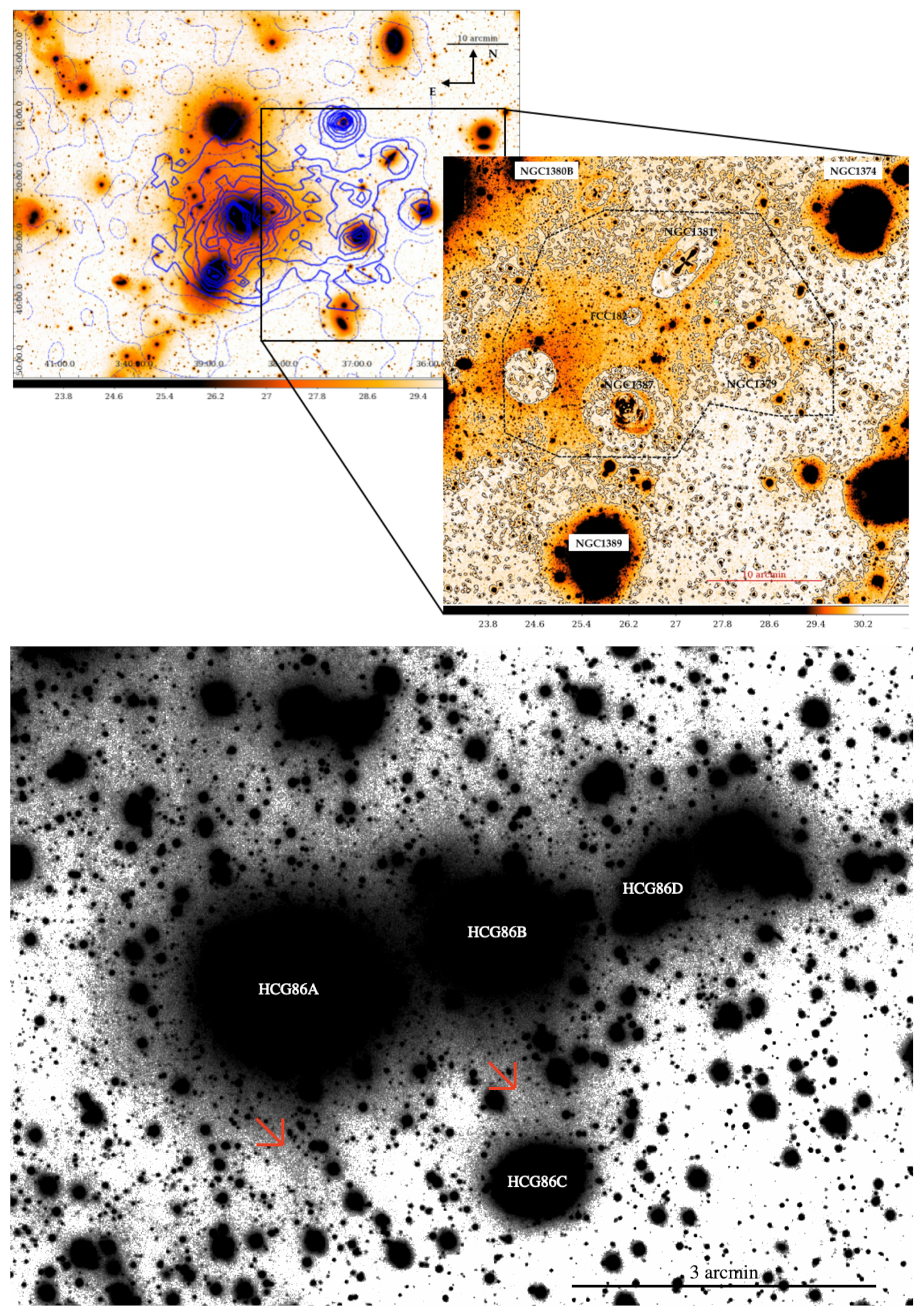

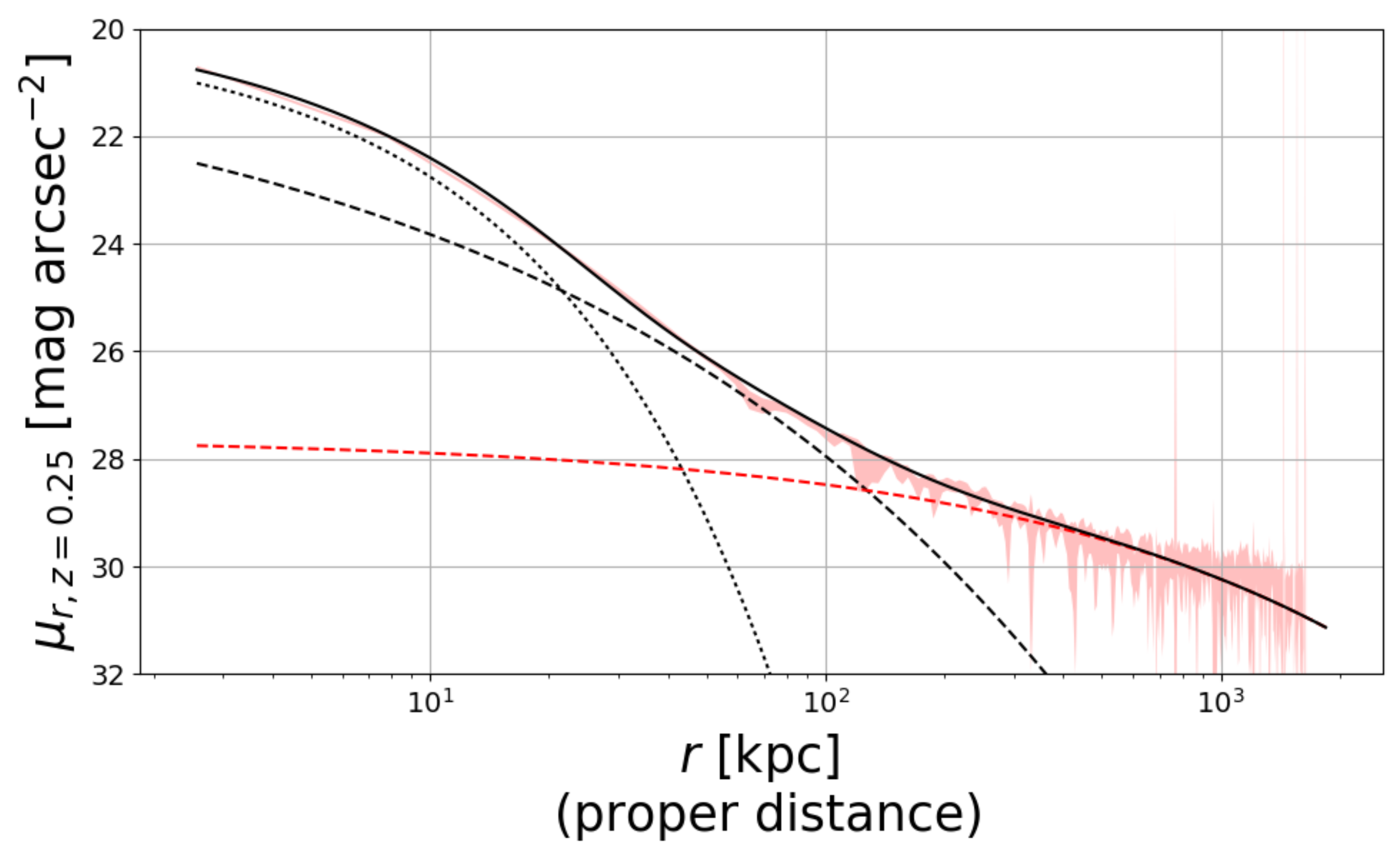



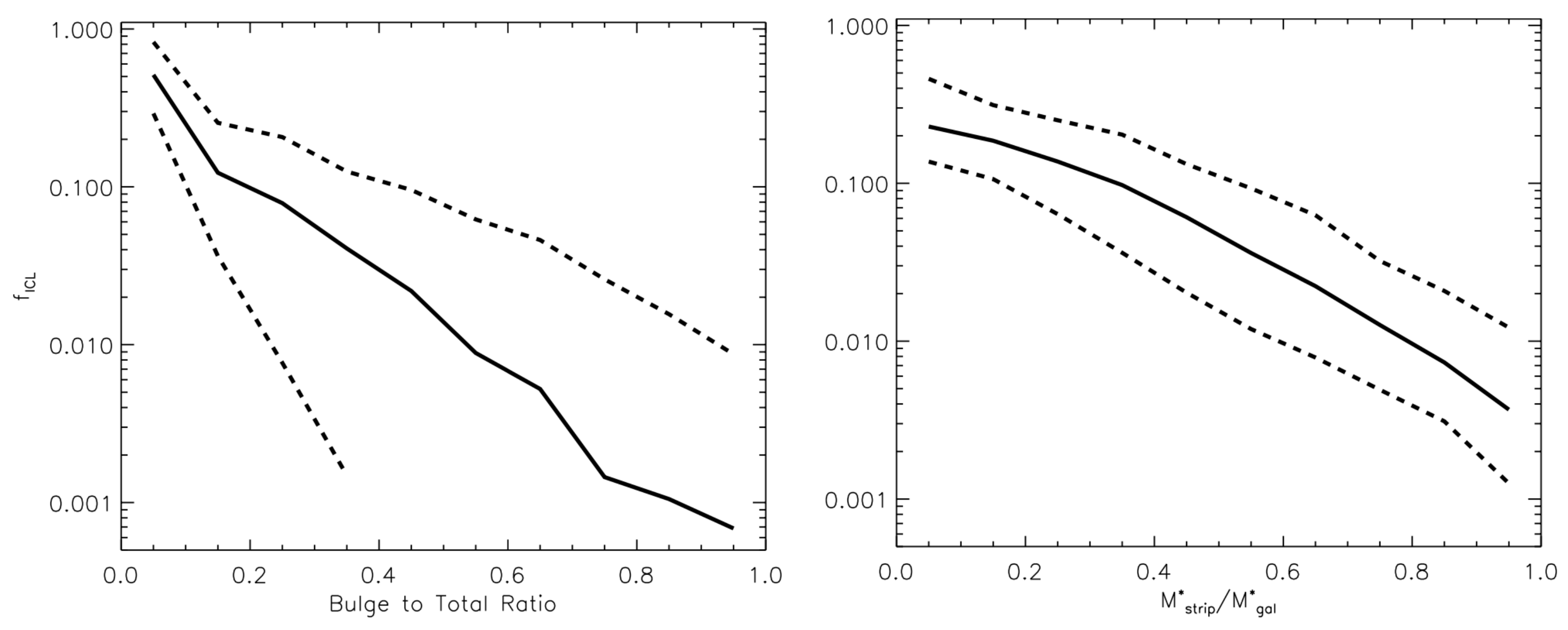
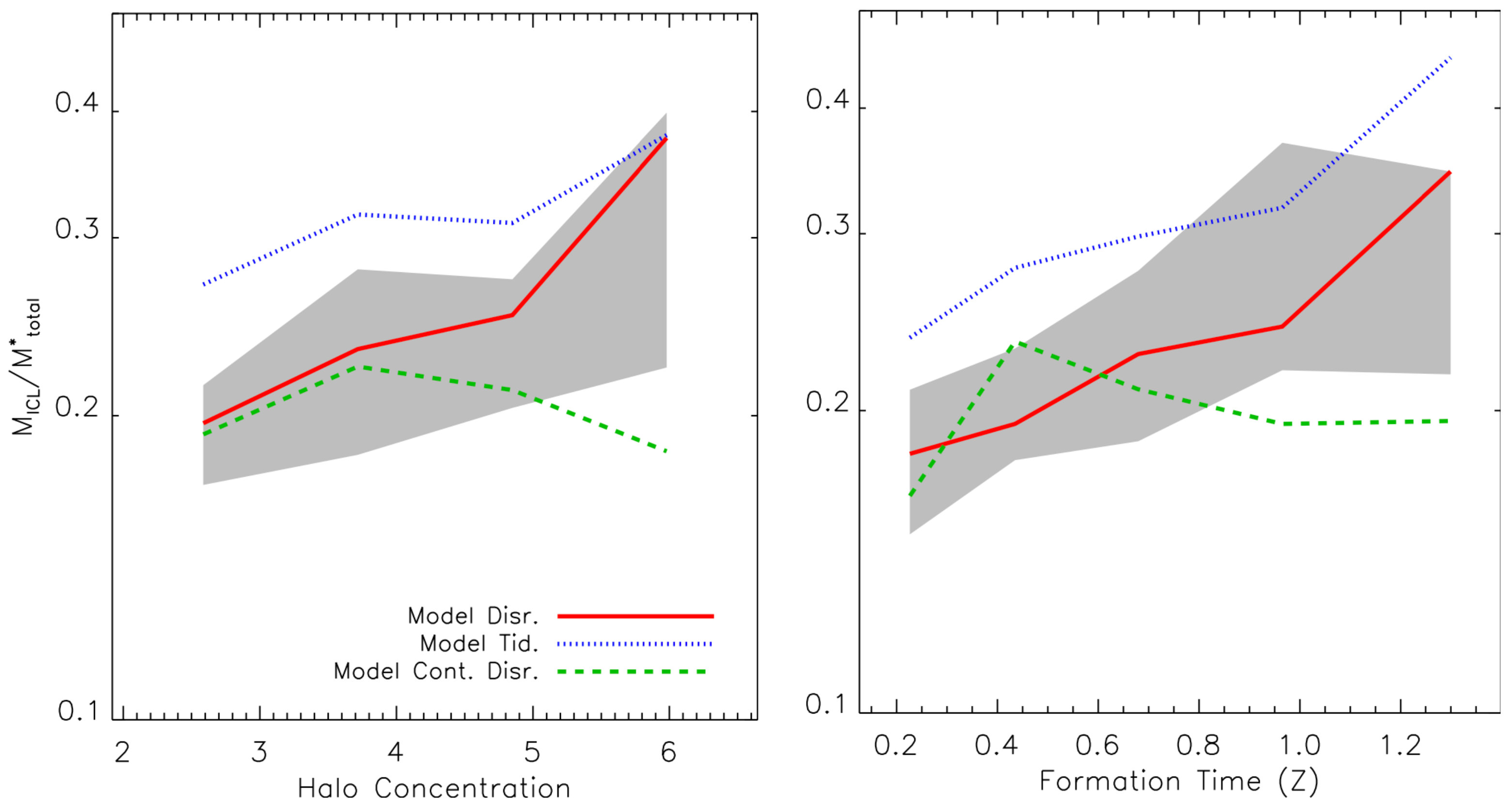
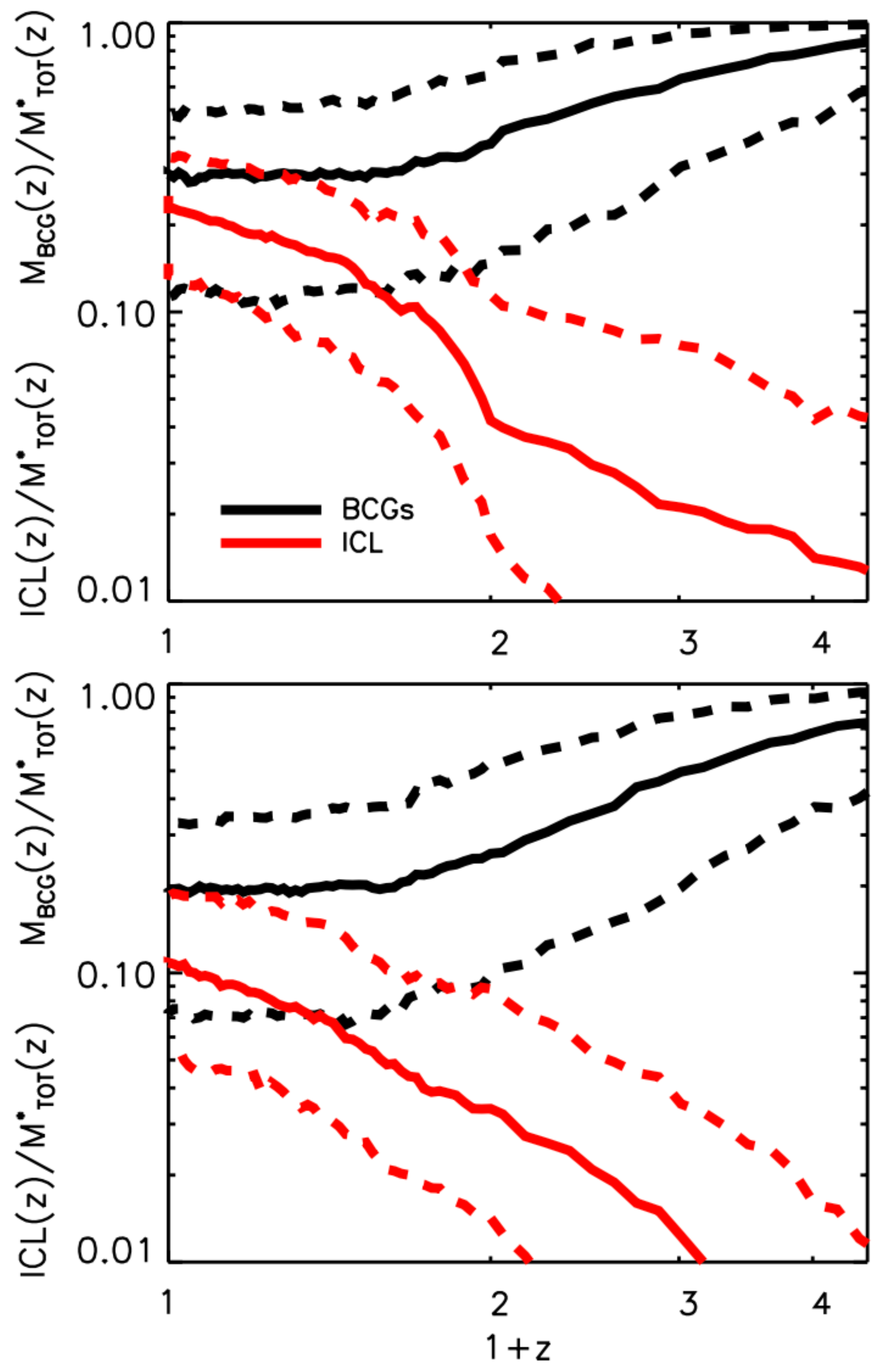

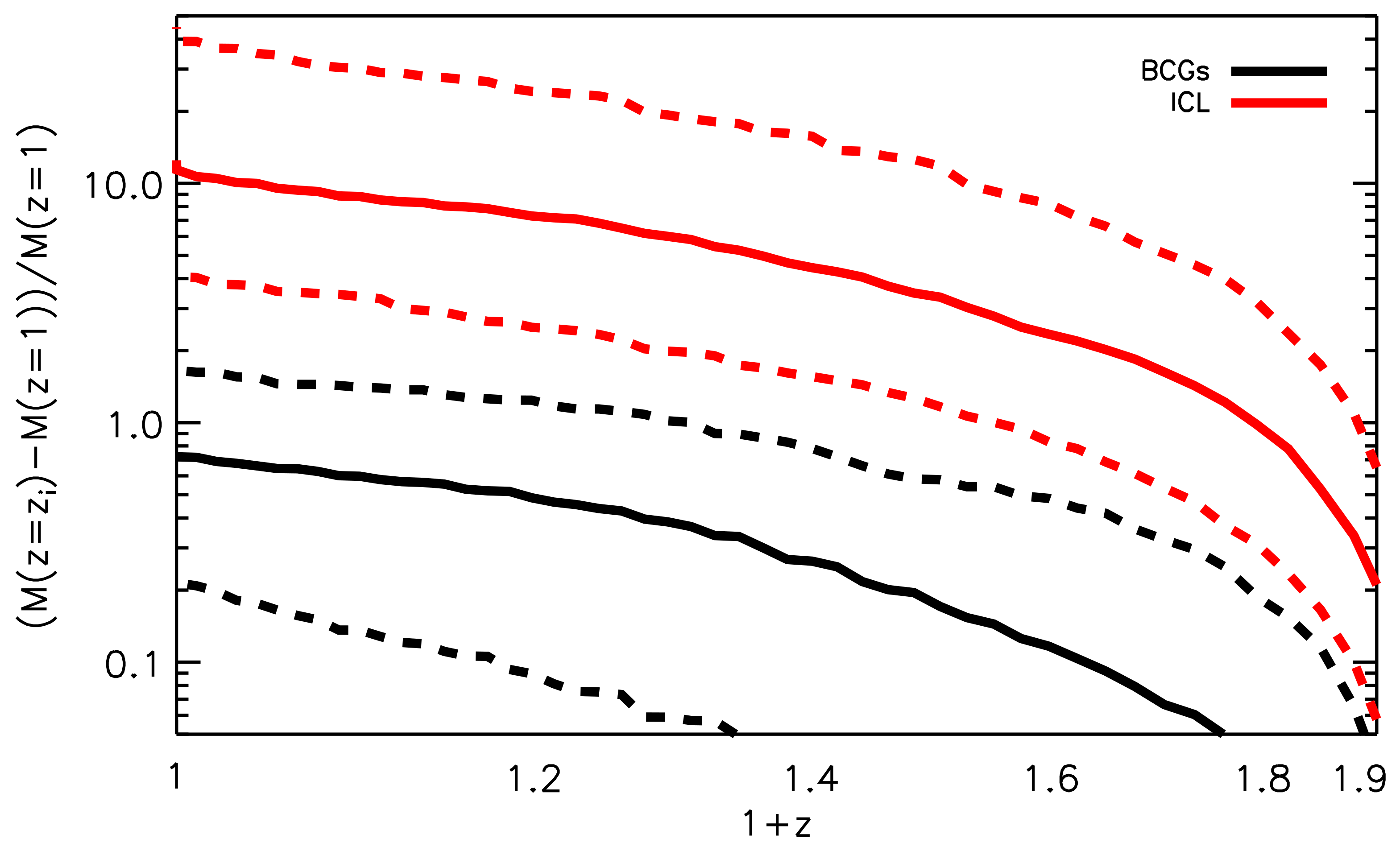
Publisher’s Note: MDPI stays neutral with regard to jurisdictional claims in published maps and institutional affiliations. |
© 2021 by the author. Licensee MDPI, Basel, Switzerland. This article is an open access article distributed under the terms and conditions of the Creative Commons Attribution (CC BY) license (https://creativecommons.org/licenses/by/4.0/).
Share and Cite
Contini, E. On the Origin and Evolution of the Intra-Cluster Light: A Brief Review of the Most Recent Developments. Galaxies 2021, 9, 60. https://doi.org/10.3390/galaxies9030060
Contini E. On the Origin and Evolution of the Intra-Cluster Light: A Brief Review of the Most Recent Developments. Galaxies. 2021; 9(3):60. https://doi.org/10.3390/galaxies9030060
Chicago/Turabian StyleContini, Emanuele. 2021. "On the Origin and Evolution of the Intra-Cluster Light: A Brief Review of the Most Recent Developments" Galaxies 9, no. 3: 60. https://doi.org/10.3390/galaxies9030060
APA StyleContini, E. (2021). On the Origin and Evolution of the Intra-Cluster Light: A Brief Review of the Most Recent Developments. Galaxies, 9(3), 60. https://doi.org/10.3390/galaxies9030060




